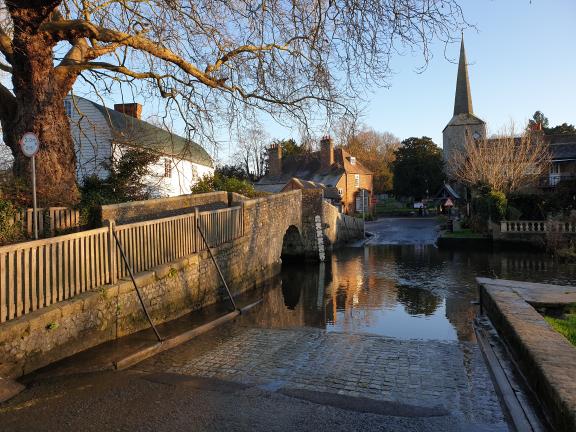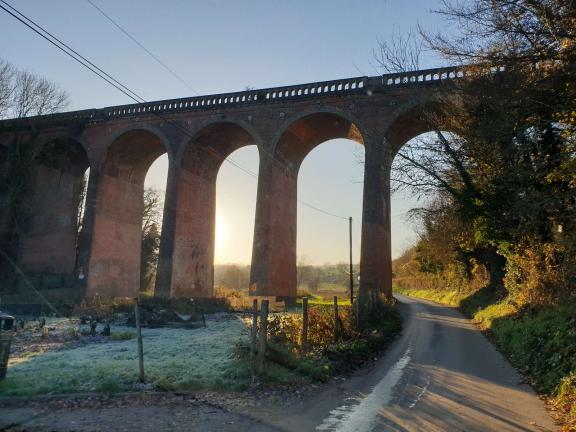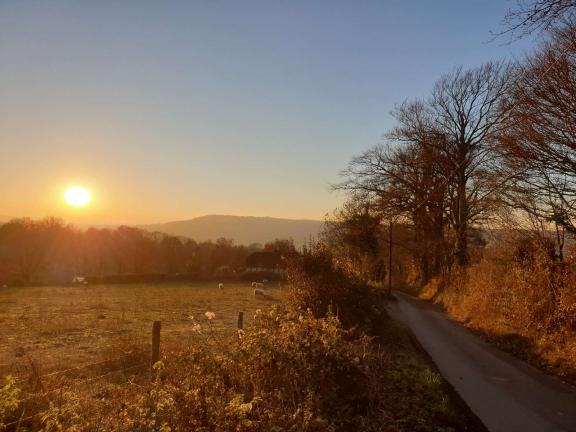After a big climb, a long flowing descent to the interesting town of Eynsford, with its own castle, you pass beneath a tall viaduct along a quiet dead-end lane which delivers you to a Roman Villa, Lullingstone Castle and The World Garden, and even a bird of prey centre. Afterwards the route continues up the far side of the valley along more quiet lanes before descending to Shoreham village where a nice tearoom, pub and even an aircraft museum round off this entertaining ride.
Farningham’s Folly Bridge
Although you can start this ride from Otford there is not a great deal of time to warm your legs up along the flat before a big climb up the steep escarpment ensues, so if would like a longer warm up we’d recommend starting at Shoreham (Filston Lane car park TN14 7SP). This also has the benefit of finishing by the Aircraft museum if you wished to visit here, and Shoreham also has a tearoom, a bakery or the nice Shaun Palmer pub.
With legs, hopefully sufficiently warmed up, and certainly still fresh, you need to power yourself up 100 metres in height within just one kilometre. It’s a well surfaced and sheltered road though, and some easier undulating country roads allow some recovery, as does the descent down into the valley beyond. After you pass through the hamlet of Knatts Valley a picturesque valley opens up ahead of you, stretching into the distance with views across the rolling fields and the sight of a lovely long sweeping descent that awaits you. At the bottom of this lovely valley is the town of Farningham, crossing the Darent River, which if you look across to your right as you cross the main bridge, you will see a Folly Bridge. Thought to have been built between 1740 and 1770 to prevent cattle from wandering downstream whilst crossing the ford, this is the only known one in the country to have been constructed in such an ornate way. It was most likely created to show off to all who travelled through Farningham how wealthy William Hanger was, who owned Farningham Manor.

Eynsford
Running parallel to the river, a quiet road guides you to Eynsford, passing a memorial placed here by Shoreham Aircraft museum to commemorate the crash site of Flt Lt James Paterson from the Royal New Zealand Air Force. In 1950 he was shot down in his Spitfire during the Battle of Britain, where he died at the early age of just 20 years old. You’re soon arriving at Eynsford, where you detour to the lovely ford, or bridge, in the village centre. It’s a fun ford for cyclists, offering enough depth for a fun splash but without significant danger and has a café, pub and even a castle to spend some time drying off at afterwards. Eynesford Castle is just around the corner and past the river too. Despite having fallen into disrepair in the 14th century, and even used as a dog kennels, it is still said to be one of the most complete Norman castles in England, and is free to enter, so well worth a visit.
Another short (and recommended) diversion at the village of Eynsford is a ride along the valley bottom, passing beneath the impressive arches of Eynsford Viaduct along the way. Shortly beyond the viaduct are the remains of a Roman Villa, said to be one of the best preserved in England, and home to a wonderful display of ancient artefacts, mosaic’s, art, costumes, facts and games that allow you to envisage life in the historic ages. There is more to come too, for at the end of this road is Lullingstone Castle and The World Garden.

Lullingstone Castle
Lullingstone Castle is one of England's oldest family estates, dating back to the time of Domesday, where it was built in 1497 and has been home to the same family ever since. The rules of lawn tennis were first codified in the estate here and both Henry VIII and Queen Anne are known to have been regular visitors and you too can visit the manor house on event days and Bank Holidays. Furthermore, in the 120 acre grounds is "Queen Anne's" Bathhouse and 18th century Ice House, a 15-acre lake and The World Garden of Plants. This dream (come true) of Tom Hart Dyke, a modern-day plant-hunter, who planned the garden during his 9-month kidnap ordeal in the Colombian jungle, combines plant heritage with cutting-edge horticulture; containing plants from around the globe planted in their respective continents of origin.
Note: Please note that beyond Lullingstone Castle, through the park to the visitors centre and café beyond is a footpath. If required though, for a short-cut, we believe you can walk this section and re-join the route back in Shoreham.
The ‘Valley of Vision’
The main route returns back under the aqueduct once more and climbs the western side of the valley now, to the town of Crockenhill. The rolling hills here are known for providing bright yellow rape fields, purple lavender, as well as blossom and wild orchids, but they were also once home to one of the country’s biggest crops of peppermint too. As you head south along a nice quiet lane the high-hedges restrict the views, but you won’t miss The Bo-Peep pub and restaurant, which offers a warm welcome, a nice garden to fuel the final leg of your journey should you wish. Gravity is on your side for a descent back down into the Darent Valley along a nice singletrack road to Shoreham, and the ‘Valley of Vision’.
Shoreham was home to Shaun Palmer the British landscape painter and key figure in Romanticism in Britain (1805-1881), who produced visionary pastoral paintings. Now hailed as a precursor of Modernism in the 20th Century, despite not being appreciated in his time, Darent Valley was his home and his ‘Valley of Vision’ where he created many of his most celebrated paintings. To see some prints of his work, and enjoy a drink, visit the Samuel Palmer pub.
Also located here in Shoreham, is the wonderful Shoreham Aircraft museum which was founded in 1978 by local enthusiasts with a passion for the Battle of Britain period. Home to hundreds of aviation relics donated and excavated from crashed British and German aircraft, flying helmets, uniforms, insignia and Home Front memorabilia it provides an enjoyable and educational visit. It is also home to a popular café which was listed in the Cyclists' Touring Club guide and is a fitting place, and way, to end this lovely ride through the Kent countryside.
Disclaimer
All routes are followed at a rider’s own risk. These routes are intended to be general guides: please observe all road signs, waymarks and other specific on-route instructions. Neither Cycling UK nor individual route authors can be held responsible for any errors or consequences that arise from using this route information. Essentially: go out, be sensible, have fun. If you believe there is an important issue with this route then please report it using the button below.

Supported by

